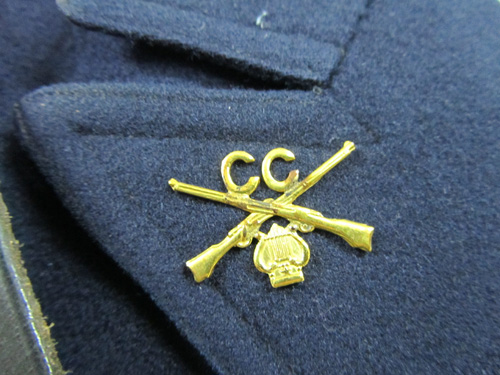December 7, 2012
Artifact: Concordia College Military Uniform
Significance: This uniform (coat, pants, gaiters, belt and hat) belonged to Raymond C. Hohenstein and was used when he attended Concordia College, Fort Wayne, Indiana (graduated 1927). Hohenstein went on to become an LCMS pastor and later a US Navy chaplain during World War II. He was stationed on the USS California at Pearl Harbor on December 7, 1941.
 Chaplain Hohenstein’s Experiences during the Attack on Pearl Harbor: Commissioned as a US Navy chaplain in 1940, Hohenstein first served on the USS Boise but was moved to the USS California in 1941. He was aboard the ship when the Japanese began their attack on the United States. Here is Chaplain Hohenstein’s account1:
Chaplain Hohenstein’s Experiences during the Attack on Pearl Harbor: Commissioned as a US Navy chaplain in 1940, Hohenstein first served on the USS Boise but was moved to the USS California in 1941. He was aboard the ship when the Japanese began their attack on the United States. Here is Chaplain Hohenstein’s account1:
Death on a Pearl Harbor Battleship
While I stood and watched, general quarters was sounded aboard. I proceeded immediately and on the double to my battle station [forward battle dressing station] on the third deck just aft turret number 2. I shouted, “This isn’t practice! This is a real raid!ˮ to everyone I passed.
When I reached my battle station, the men were already closing the watertight doors. A few moments later the ship shook violently from an explosion that seemed to come directly beneath us. Before long, we smelled fumes. No one knew what they were, but we all felt dizzy. We must find our gas masks!
 We broke open the watertight door on the starboard side of the passageway around the barbette (armor shield) of turret number 2. But once the door opened, we forgot all about the masks. We saw men knee-deep in fuel oil, some already overcome by the fumes. We worked to help these men over the high coaming (a raised frame around the hatchway) into our compartment, where the starboard side was still dry. The ship already had listed to port.
We broke open the watertight door on the starboard side of the passageway around the barbette (armor shield) of turret number 2. But once the door opened, we forgot all about the masks. We saw men knee-deep in fuel oil, some already overcome by the fumes. We worked to help these men over the high coaming (a raised frame around the hatchway) into our compartment, where the starboard side was still dry. The ship already had listed to port.
Before long, though, the fumes affected us all. When my legs no longer supported me, I tried to get out of the way so others could work. I lost consciousness.
 I don’t know how much time elapsed. When I came to, I was lying on the starboard quarterdeck directly outside the door of the crew’s lounge. I remember someone saying that all the injured must be moved inside. The Japs2 were strafing the ships.
I don’t know how much time elapsed. When I came to, I was lying on the starboard quarterdeck directly outside the door of the crew’s lounge. I remember someone saying that all the injured must be moved inside. The Japs2 were strafing the ships.
In the passageway stood one of our Guamian mess boys, also semiconscious from the fumes. When he recognized me, he clung desperately to me. In that moment all color, creed and military differences vanished. We were simply two Christians praying for God’s mercy and professing our common Christian faith in the Apostles’ Creed.
 During that moment of prayer another terrific explosion shook the ship (evidently the bomb amidships) that filled the passageway with smoke and debris. I lost consciousness again.
During that moment of prayer another terrific explosion shook the ship (evidently the bomb amidships) that filled the passageway with smoke and debris. I lost consciousness again.
When I awoke, I was lying again on the starboard quarterdeck. Thinking the ship might capsize (as someone
said the USS Oklahoma had), I kicked off my shoes, ready to leap into the water. But we, the injured, were taken off ship.
The damages to the USS California were severe, and the ship eventually sank. Chaplain Hohenstein’s injuries consisted of flash burns to the face, scalp and right arm. Hohenstein was the first living navy chaplain to receive the Purple Heart, which he was awarded in 1943 for the wounds he received during the attack.
Additional information about Chaplain Hohenstein’s ministry can be found in Historical Footnotes 52 (No. 1,
Spring 2007). Click on the “CHI Publicationsˮ tab above and follow the links to view previous issues of Historical Footnotes.
__________



